iPhone 12 Pro
Apple's previous-generation Pro-level iPhones. iPhone 12 Pro and iPhone 12 Pro Max.

iPhone 12 Pro Discontinued
Apple discontinued the iPhone 12 Pro and the iPhone 12 Pro Max in September 2021, replacing them with the iPhone 13 Pro and iPhone 13 Pro Max. With the launch of the new iPhones, Apple is no longer offering the iPhone 12 Pro and 12 Pro Max for sale, but it may still be available from third-party vendors.
iPhone 12 Pro and iPhone 12 Pro Max Overview
Contents
- iPhone 12 Pro Discontinued
- iPhone 12 Pro and iPhone 12 Pro Max Overview
- Pricing and Availability
- Reviews
- Issues
- Design
- Display
- A14 Bionic Chip
- TrueDepth Camera and Face ID
- Triple-Lens Rear Camera
- Battery Life
- 5G Connectivity
- Bluetooth, WiFi, and U1 Chip
- Other Features
- MagSafe
- No Power Adapter
- iPhone 12
- iPhone 12 Pro Timeline
Apple on October 13, 2020 unveiled the iPhone 12 Pro and iPhone 12 Pro Max, were sold alongside the more affordably priced iPhone 12 and iPhone 12 mini. Apple heavily emphasized the "Pro" aspect of the new iPhone 12 Pro models, suggesting the more expensive iPhones "push the boundaries of innovation" for the people who "want the absolute most out of their iPhones."
Available in 6.1-inch and 6.7-inch size options, the two new Pro models feature full-screen Super Retina XDR displays that are edge-to-edge with the exception of the Face ID notch.
The 6.1-inch iPhone 12 Pro has a resolution of 2532 x 1170 with 460 pixels per inch, while the 6.7-inch iPhone 12 Pro Max has a resolution of 2778 x 1284 and a 458 ppi. The displays offer HDR support with 1200 nits peak brightness, Wide Color, Haptic Touch, and True Tone, all features that have been introduced over the years.
Protecting the displays is a new Ceramic Shield cover, which Apple says "goes beyond glass" and is tougher than any smartphone glass. It's infused with nano-ceramic crystals and offers 4x better drop performance.
The iPhone 12 Pro and Pro Max have an entirely new look that's similar to the design of the iPad Pro with flat edges instead of the rounded edges used in prior models. There's a precision-milled matte glass back surrounded by a stainless steel band.
Color options include graphite, silver, gold, and pacific blue, with the blue shade replacing the midnight green used last year. The iPhone 12 Pro and Pro Max offer IP68 water and dust resistance and can hold up to submersion in 6 meters of water for up to 30 minutes.
The new iPhone 12 models are the first to feature 5G connectivity for faster downloads and uploads, better quality video streaming, improved gaming, and higher-definition 1080p FaceTime calls. To preserve battery life when using 5G, a Smart Data Mode reverts to an LTE connection when 5G speeds aren't necessary.
5G coverage is available worldwide, but only iPhone 12 devices sold in the United States support mmWave 5G, which is the fastest 5G technology available. iPhone 12 models sold in other countries are limited to the slower but more widely available Sub-6GHz 5G connectivity. In the U.S., 5G speeds can be as high as 4Gbps, even in highly populated areas.
Gigabit LTE is supported when 5G isn't available, as is WiFi 6 and Bluetooth 5.0. Like the iPhone 11 models, the iPhone 12 Pro models include a U1 Ultra Wideband chip for spatial awareness and interactivity with other devices that include the U1 feature such as the HomePod mini.
There's a new A14 chip inside the iPhone 12 Pro models, and it is the first chip in the smartphone industry built on a 5-nanometer process for performance and efficiency improvements. Apple says the 6-core CPU and 4-core GPU in the A14 are 50 percent faster than the fastest competing smartphone chips. The A14 chip includes a 16-core Neural Engine that offers an 80 percent increase in performance for machine learning tasks.
For the most part, the iPhone 12 Pro and iPhone 12 Pro Max offer identical specs, but the exception is the camera, where there are some notable differences. The iPhone 12 Pro is equipped with a new seven-element Wide camera with an f/1.6 aperture, which brings 27 percent improved low-light performance for photos and videos.
There's also an Ultra Wide camera with a 120-degree field of view and a 52mm telephoto lens that offers 4x optical zoom.
The iPhone 12 Pro Max also has a seven-element Wide camera with an f/1.6 aperture, but it has a 47 percent larger sensor for an 87 percent improvement in low light. It has the same Ultra Wide camera and a 65mm telephoto lens that enables 5x optical zoom.
While the iPhone 12 Pro offers dual optical image stabilization, the iPhone 12 Pro Max supports sensor-shift optical image stabilization for the Wide lens that stabilizes the sensor instead of the lens itself. Sensor-shift stabilization has previously been limited to DSLRs, and it offers better than ever stabilization for photos and videos.
For both models, A14 chip powers a new image signal processor and computational photography capabilities that weren't possible before. Night mode is now available for the front-facing TrueDepth camera and the Ultra Wide camera, and Deep Fusion is available for all cameras. A new Smart HDR 3 feature brings more true-to-life images.
There's also support for ProRAW, a feature that combines Apple's image processing and computational photography with the versatility of the RAW file format, offering full control over color, detail, and dynamic range.
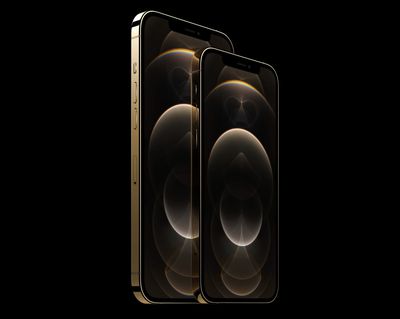
As for video, the iPhone 12 Pro models support 4K 60fps video and HDR video recording with Dolby Vision at up to 60 frames per second, and better video stabilization. A Night mode time-lapse video option allows for impressive night time videos when a tripod is used.
The iPhone 12 Pro and Pro Max are equipped with a LiDAR Scanner that measures light distance and pixel depth of a scene to map out the area around the iPhone. It allows for more realistic AR experiences and it improves autofocus by 6x in low-light scenes for improved accuracy. The LiDAR Scanner enables Night mode portraits.
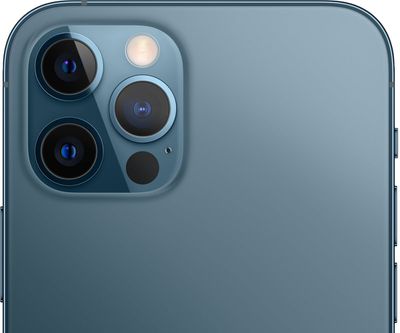
Apple's iPhone 12 Pro and Pro Max continue to use the same Face ID facial recognition system powered by the front-facing TrueDepth camera system, which features a 12-megapixel camera for selfies and Smart HDR, Deep Fusion, and Night mode.
When it comes to battery life, the iPhone 12 Pro offers up to 18 hours of video playback, 11 hours of streaming video playback, or 65 hours of audio playback. The iPhone 12 Pro Max offers up to 20 hours of video playback, 12 hours of streaming video playback, or 80 hours of audio playback, for the longest battery life in an iPhone yet.
Both of the new iPhones offer fast charging, which provides a 50 percent charge in 30 minutes using a 20W power adapter.
To go along with the new iPhone 12 models, Apple introduced new MagSafe accessories designed to work with a ring of magnets built into the new devices. There's a MagSafe charger plus MagSafe cases and wallet accessories. MagSafe supports 15W wireless charging, an upgrade over the 7.5W charging available through standard Qi-based wireless chargers.
Apple sold the iPhone 12 Pro and Pro Max alongside the iPhone 12 mini and iPhone 12, more affordable 5.4 and 6.1-inch devices that lack some of the Pro camera features and design elements included in the iPhone 12 Pro and Pro Max. More info on the iPhone 12 lineup can be found in our iPhone 12 roundup.
Note: See an error in this roundup or want to offer feedback? Send us an email here.
Pricing and Availability
The 6.1-inch iPhone 12 Pro launched on Friday, October 23, 2020. It was priced starting at $999 for 128GB of storage, with 256 and 512GB of storage available for $1,099 or $1,299, respectively.
The 6.7-inch iPhone 12 Pro Max launched on Friday, November 13, 2020. Pricing on the iPhone 12 Pro Max started at $1,099 for 128GB of storage, with 256 and 512GB of storage available for $1,199 or $1,399, respectively.
Apple Card Monthly Installments are also available, with the iPhone 12 available starting at $41.62 per month and the iPhone 12 Pro Max available starting at $45.79 per month. iPhone Upgrade Program payments for the new devices start at $49.91 per month.
Reviews
iPhone 12 Pro
Reviews of the iPhone 12 Pro were largely positive, with reviewers praising the camera changes. Low-light performance, noise reduction, and contrast are improved, as demoed in review videos below.
The camera also supports HDR video recording in Dolby Vision, and Night mode selfies, which are a nice addition to the front-facing camera. The Ultra Wide camera distorts less at the edges, and the photos from the Ultra Wide and Telephoto lenses are a good deal sharper and crisper.
Most people won't need HDR footage or workflows because video shot in HDR and shared on a social network won't see much improvement, but those who use the iPhone as a filmmaking tool or make high-quality videos as a hobby should appreciate the new HDR video support.
On the negative side, reviewers weren't impressed with 5G, as the rollout of 5G networks is still in progress and it's not widely available as of yet, plus the fastest mmWave 5G can drain battery. LiDAR was also described as being a bit gimmicky because of its AR functionality, but also useful for autofocus in low-light situations.
When it comes to design, The Verge's Nilay Patel said that the iPhone 12 Pro's stainless steel frame is a fingerprint magnet, while TechCrunch's Matthew Panzarino said that he hopes the brighter colors of the iPhone 12 eventually come to the much more muted 12 Pro lineup.
The display was described as "excellent," but it is of course similar to the iPhone 11 Pro display, and there are no changes to the notch size. There were rumors about a 120Hz refresh rate that would make scrolling smoother and the display more responsive, but that didn't end up happening and many reviewers complained about the 60Hz limitation given that 120Hz is standard on high-end Android devices.
iPhone 12 Pro Max
The iPhone 12 Pro Max has all of the same features as the iPhone 12 Pro, with the addition of some extra camera enhancements and a larger battery thanks to the larger size. Reviews of the 12 Pro Max were also positive, with reviewers praising the larger 6.7-inch display and long battery life.
The iPhone 12 Pro Max is big enough that people should see it in person before ordering it, and reviewers were disappointed that Apple isn't doing more to take advantage of the larger screen with multitasking and other features.
With its larger size and bigger battery, the 12 Pro Max easily lasts all day and sometimes even more, depending on 5G usage.
Reviewers agreed that the iPhone 12 Pro and Pro Max produce similar photos despite the larger sensor and improved telephoto lens in the bigger model, but there is a noticeable difference when it comes to lower lighting conditions. In these situations, the Pro Max produces crisper, less noisy images, and it also has a better 2.5x zoom range.
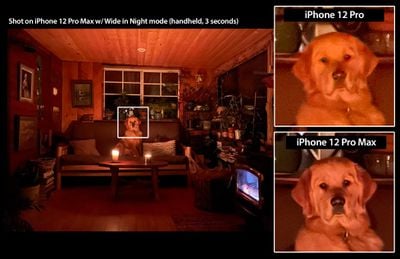
Reviews are useful to check out if you're on the fence about a new iPhone purchase, and more info can be found in our dedicated review roundups for iPhone 12 Pro and iPhone 12 Pro Max. Make sure to also check out our first impressions coverage with thoughts on the new devices from MacRumors readers.
Issues
In August 2021, Apple launched a new service program for iPhone 12 and iPhone 12 Pro models to address an issue that can cause some devices to experience sound issues. According to Apple, a "very small percentage" of iPhone 12 and iPhone 12 Pro models may experience sound problems because of a component that can fail on the receiver module. Affected devices were manufactured between October 2020 and April 2021.
iPhone 12 and iPhone 12 Pro owners who have a device that does not emit sound from the receiver when making or receiving phone calls may be eligible for free service with an appointment at an Apple retail location, an Apple Authorized Service Provider, or via a mail-in repair. iPhone 12 mini and iPhone 12 Pro Max models are not affected.
Design
Apple has used the same rounded edge design since the iPhone 6, but that changed in 2020 with the unveiling of the iPhone 12 lineup. The iPhone 12 Pro and 12 Pro Max adopt a flat-sided design with squared off edges, which matches the design language of the iPad Pro and harkens back to older devices like the iPhone 4 and the iPhone 5.
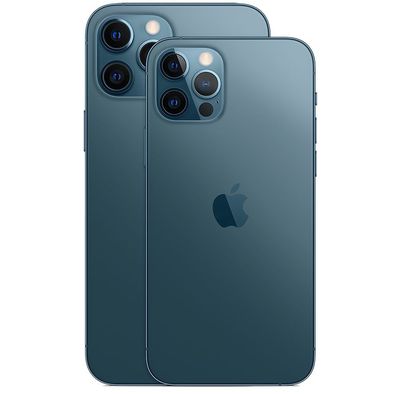
The flat-edged design is a significant departure from the prior design, which makes the new models feel modern, but given that it reintroduces a look from older models, it also feels familiar.
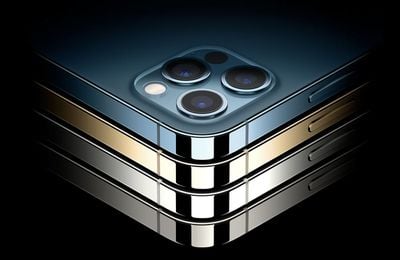
The all-glass front and textured glass back are sandwiched between a shiny, surgical-grade stainless steel frame in colors that match the back glass. The front of the iPhone 12 Pro and Pro Max have slimmer bezels, but there continues to be a notch at the front to house the TrueDepth Camera, a speaker, and a microphone.
There are antenna bands at the top and sides of the phone, along with the standard power button on the right and volume buttons on the left. Underneath the power button, there's a new 5G mmWave antenna, but this is a feature limited to the U.S. models that have mmWave support. iPhones in other countries do not have this antenna. iPhones purchased in European countries have regulatory information etched into the side.
At the bottom of the iPhone 12 Pro models there are speaker holes and built-in microphones, along with a Lightning port that supports charging over Lightning, and the SIM slot has been moved to the left.
The back of the iPhone has a square camera bump at the top that houses a triple-lens camera setup along with a flash and a new LiDAR sensor. Below that, there's an Apple logo that matches the stainless steel frame.
Sizes
This year's iPhone 12 Pro models come in 6.1 and 6.7-inch sizes, with the 6.7-inch model positioned as the largest iPhone that Apple has released to date. Compared to the iPhone 11 Pro models, Apple's iPhone 12 Pro models have been slimmed down and are slightly smaller.
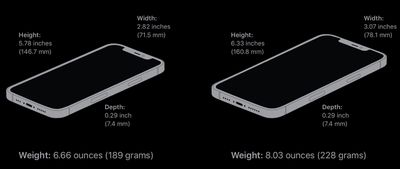
The iPhone 12 Pro measures in at 5.78 inches tall (146.6mm), 2.82 inches wide (71.5mm), and 0.29 inches thick (7.4mm), while the iPhone 12 Pro Max measures in at 6.33 inches tall (160.8mm), 3.07 inches wide (78.1mm), and 0.29 inches thick (7.4mm).
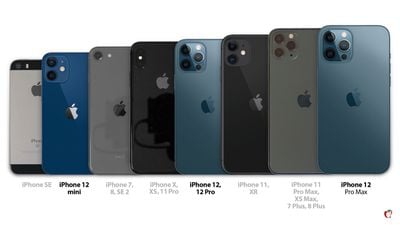
Colors
The iPhone 12 Pro and 12 Pro Max come in silver, gold, graphite, and pacific blue, a deep blue color that's new to the Pro iPhone lineup. Pacific blue replaces the midnight green color that was introduced with the iPhone 11 Pro lineup.
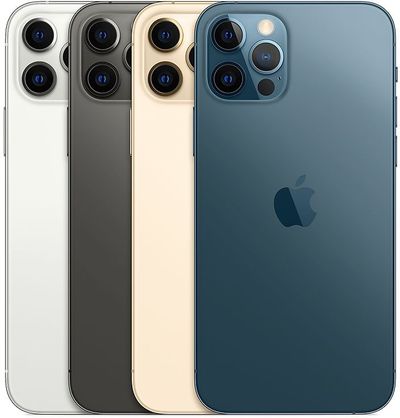
Water Resistance
The iPhone 12 Pro and Pro Max, like the iPhone 11 Pro models, feature an IP68 water resistant rating. The new smartphones are able to withstand a depth of up to six meters (19.7 feet) for up to 30 minutes.
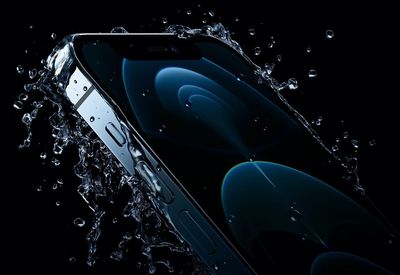
Prior iPhone models were rated to withstand water up to four meters deep for 30 minutes, so despite the similar water resistance rating, the new iPhones can hold up better to deeper submersion.
In the IP68 number, the 6 refers to dust resistance (and means the iPhone 12 Pro can hold up to dirt, dust, and other particulates), while the 8 pertains to water resistance. IP6x is the highest dust resistance rating that exists.
With the IP68 water resistance rating, the iPhone 12 Pro can hold up to splashes, rain, and accidental water exposure, but intentional water exposure should be avoided if possible.
Water and dust resistance are not permanent conditions, according to Apple, and can deteriorate over time as a result of normal wear. Apple's warranty does not cover liquid damage, which means it's best to use caution when it comes to liquid exposure.
Display
All of the iPhone 12 models feature the same OLED Super Retina XDR display, which is flexible and extends right into the chassis of each device.

There's an improved 2,000,000:1 contrast ratio for blacker blacks and brighter whites, and up to 1200 nits peak brightness for HDR photos, videos, TV shows, and movies. Typical max brightness is an improved 800 nits.
The 6.1-inch iPhone 12 Pro features a resolution of 2532 x 1170 with 460 pixels per inch, while the 6.7-inch iPhone 12 Pro Max has a resolution of 2778 x 1284 with 458 pixels per inch, equating to more than 3.4 million pixels.
Wide color support ensures vivid, true-to-life colors, and True Tone matches the white balance of the display to the ambient lighting for a paper-like viewing experience that's easier on the eyes.
There's also a fingerprint-resistant oleophobic coating and support for Haptic Touch, which provides haptic feedback when interacting with the display. Haptic Touch is enabled through a smaller Taptic Engine in the 2020 iPhones.
Apple's iPhone 12 Pro Max earned the "Best Smartphone Display Award" from DisplayMate thanks to the iPhone's "state-of-the-art" display that has the highest-sever display performance with high peak brightness, high contrast ratio, low reflectance, and color accuracy. It's also more power efficient than the OLED display in the iPhone 11 Pro Max.
Ceramic Shield
This year's displays are protected by a "Ceramic Shield" material that Apple says delivers four times better drop protection. The Ceramic Shield display cover is made by infusing nano-ceramic crystals into glass, which Apple says required quite a bit of work because ceramic is not transparent.
The ceramic crystals were manipulated to optimize for clarity while maintaining toughness, with the display created in partnership with Corning. The iPhone 12 Pro's display was also designed to sit flush with the edge of the phone, a feature that Apple says also contributes to better drop protection.
According to Apple, Ceramic Shield is tougher than any smartphone glass, with a dual-ion exchange process ensuring protection against scratches and everyday wear and tear. Early tests have confirmed that Apple's estimates appear to be accurate, and the iPhone 12's Ceramic Shield is more durable than the glass protecting the iPhone 11, better resisting force tests and drops.
In a drop test, the iPhone 12 and 12 Pro displayed more durability than previous iPhone models, outperforming the iPhone 11 and 11 Pro in drop tests, but it's still vulnerable to breaking.
Though more resistant to breakage when dropped, the Ceramic Shield does not appear to be able to better hold up to scratching, and in a Mohs hardness test, the iPhone 12's display scratched at a level 6 with deeper grooves caused at level 7. Apple has not said that the new iPhones offer better scratch protection.
A14 Bionic Chip
The A14 Bionic chip used across the iPhone 12 lineup was the first A-series chip built on a smaller 5-nanometer process, which brings speed and efficiency improvements. The A14 features 40 percent more transistors (11.8 billion) than the A13, for better battery life and faster performance.
According to Apple, the 6-core CPU and 4-core GPU in the A14 Bionic chip is 50 percent faster than any other top smartphone chip on the market in 2020.
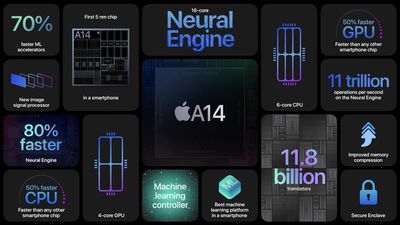
Early Geekbench benchmark results suggest the iPhone 12 Pro is more than 20 percent faster than the iPhone 11 Pro with A13 chip, while the iPhone 12 Pro Max is seeing results that are approximately 20 to 25 percent faster.
Neural Engine
There's a new 16-core Neural Engine that's 80 percent faster than the prior-generation Neural Engine, and the machine learning accelerators are up to 70 percent faster. The Neural Engine can complete 11 trillion operations per second, so tasks like applying Deep Fusion improvements to photos are faster than ever.
Other improvements include a new image signal processor for Dolby Vision recording support, Smart HDR 3 for more true-to-life color shifts in photos, and advanced temporal noise reduction that cuts down on noise in videos.
RAM
The iPhone 12 Pro and iPhone 12 Pro Max have 6GB RAM.
TrueDepth Camera and Face ID
For biometric authentication purposes, the iPhone 12 Pro and Pro Max use Face ID, the facial recognition system that was first introduced in 2017. Face ID components are housed in the TrueDepth camera system in the display notch.
Face ID is used across iOS tasks for unlocking the iPhone, allowing access to third-party passcode-protected apps, confirming app purchases, and authenticating Apple Pay payments.

Face ID works through a set of sensors and cameras. A Dot Projector projects more than 30,000 invisible infrared dots onto the surface of the skin to create a 3D facial scan that maps the curves and planes of each face, with the scan read by an infrared camera.
The facial depth map is relayed to the A14 chip where it is transformed into a mathematical model that the iPhone uses to authenticate identity. Face ID works in low light and in the dark, and with hats, beards, glasses, sunglasses, scarves, and other accessories that partially obscure the face.
Face ID data is stored in the Secure Enclave, and it is not accessible to Apple, third-party apps, or anyone who has your phone. Authentication happens on-device and no Face ID data is uploaded to Apple.
Using Face ID With a Mask
When wearing a face mask, users can enable an "Unlock with Apple Watch" feature for convenience. Unlock with Apple Watch allows iPhone users to take advantage of an unlocked and authenticated Apple Watch as an alternative authentication measure to unlock their device when wearing a mask. It can't be used to authenticate Apple Pay or App Store purchases, and it can't unlock apps that require a Face ID scan.

In iOS 15.4, Apple added the ability for Face ID to work with face masks, with no need for an Apple Watch for authentication. Apple says that the feature can "recognize the unique features around the eye" for authentication purposes. If you opt to use this feature during setup, you will need to rescan your face for Face ID. From there, Face ID will be able to unlock your iPhone even when you're wearing a mask.
Apple warns in the Settings app that Face ID is "most accurate" when it's set up for full-face recognition only. For Face ID with a mask to work, you must be looking at your device to get it to unlock, and it does not work when wearing sunglasses. Face ID with a mask can authenticate Apple Pay payments and it can be used in lieu of a login and password in apps that support Face ID, unlike the prior Apple Watch Face ID feature.
- Face ID With a Mask: How It Works and What You Need to Know
- iOS 15.4: How to Set Up Face ID With a Mask
The new feature is only available with the iPhone 12 or newer. iOS 15.4 has not yet been widely released to the public and is currently in beta testing.
Camera Features
In addition to powering facial recognition, the 12-megapixel f/2.2 camera in the TrueDepth camera system is also a front-facing selfie/FaceTime camera with many of the same features that are available for the rear-facing camera.
The A14 chip in the iPhone 12 Pro models brings new photographic features to the front-facing TrueDepth camera. Night mode works with the front-facing camera for the first time, enabling nighttime selfies.

Deep Fusion, Smart HDR 3, and Dolby Vision HDR video recording are also supported. Deep Fusion introduces improvements in color and texture in mid to low-light scenes by pulling out the best pixels from multiple exposures to make one great aggregate image.
Smart HDR 3 improves highlights, shadows, white balance, and contouring in every image for more natural lighting, and Dolby Vision HDR support allows for recording and editing Dolby Vision video.
4K video recording at up to 60 frames per second is supported, as is 1080p slo-mo video at 120 frames per second for taking "slofie" videos. Other front-facing camera features include support for Memoji and Animoji, time-lapse video, Night mode time-lapse, QuickTake video, and lens correction for removing any photo distortion.
Triple-Lens Rear Camera
Last year's iPhone 11 Pro models had the same camera equipment and were identical except for size, but that's not the case this year. The iPhone 12 Pro and 12 Pro Max support different camera technology, with the Pro Max offering a more feature rich experience. That said, there are still many similarities between the two, and both have a new LiDAR sensor.

Both the iPhone 12 Pro and Pro Max have triple-lens camera systems, but there are different telephoto lenses and different sensors for the Wide camera.
iPhone 12 Pro Camera
- 12-megapixel 5-element Ultra Wide lens with f/2.4 aperture, 120 degree field of view, 13mm focal length, and Lens Correction to account for distortion
- 12-megapixel 7-element Wide lens with f/1.6 aperture, optical image stabilization, and 26mm focal length
- 12-megapixel 6-element telephoto lens with f/2.0 aperture, 52mm focal length, 2x optical zoom (4x optical zoom range), up to 10x digital zoom, and optical image stabilization
The f/1.6 aperture in the 7-element Wide lens allows for 27 percent more light, which brings improvements to low-light photography. The 7-element design adds edge-to-edge sharpness, and an improved Optical Image Stabilization system makes 5000 adjustments per second.
iPhone 12 Pro Max Camera
- 12-megapixel 5-element Ultra Wide lens with f/2.4 aperture, 120 degree field of view, 13mm focal length, and Lens Correction to account for distortion
- 12-megapixel 7-element Wide lens with f/1.6 aperture, 47% larger sensor, larger pixels, sensor-shift optical image stabilization, and 26mm focal length
- 12-megapixel 6-element telephoto lens with f/2.2 aperture, 65mm focal length, 2.5x optical zoom (5x optical zoom range), up to 12x digital zoom, and optical image stabilization
The Wide lens in the iPhone 12 Pro Max has the same f/1.6 aperture, but it's using a 47 percent larger sensor with bigger pixels that lets in a lot more light. Apple says low-light photos taken with the iPhone 12 Pro Max are 87 percent better, and images also feature more detail and better color.

The Telephoto camera has a longer focal length, allowing for 5x zoom instead of 4x zoom, and the Ultra Wide camera is the same between both models.
Notably, the Wide camera of the iPhone 12 Pro Max supports sensor-shift optical stabilization, a feature that's previously been limited to DSLRs. Sensor-shift optical stabilization, as the name suggests, stabilizes just the sensor, allowing it to be kept steadier than before.
With this feature, the iPhone 12 Pro Max has much better optical image stabilization that cuts down on camera shake and blur from movement.
LiDAR Sensor
The iPhone 12 Pro and the iPhone 12 Pro Max are the first iPhones to be equipped with a LiDAR Scanner, which was first introduced in the 2020 iPad Pro models.
The LiDAR Scanner measures how long it takes light to reflect back from objects that are around you, allowing you to create a depth map of the room or area that you're in. The light measurements happen in nanoseconds so it takes no time at all for the iPhone to map out the area surrounding you.
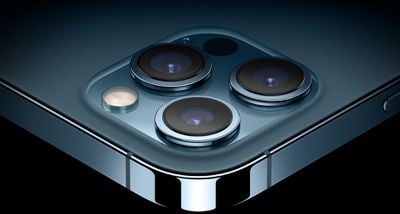
Augmented reality experiences are more immersive and accurate thanks to the depth map that the LiDAR Scanner creates, with virtual objects able to be placed accurately within a space and apps able to take advantage of detailed representations of every surface in the room. The LiDAR Scanner also allows for accurate measurements, including height measurements for people.
LiDAR also brings significant photography improvements. Autofocus is six times faster in low light, and with the Wide camera, LiDAR enables Night mode portrait shots for the first time.
New Camera Features
The updated camera setups in the iPhone 12 Pro and Pro Max models paired with the image signal processor in the A14 chip and the LiDAR Scanner enable several new features.
- Night Mode Portraits - With the Wide camera, you can now take Portrait shots in Night mode with bright colors and artful bokeh for streetlights and other lighting in the shot.
- Night Mode for Ultra Wide - Night mode in the new models works with both the Wide and Ultra Wide lenses so you can get nighttime wide-angle shots.
- Deep Fusion - Deep Fusion now works with the Ultra Wide, Wide, and Telephoto lenses to bring improvements to color and texture in mid to low-light scenes. With Deep Fusion, multiple exposures are analyzed on a pixel level to bring out detail in all objects in the image.
- Better Portrait shots - Improved machine learning makes the iPhone 12 Pro models better at separating the subject from the background.
- Smart HDR 3 - Refines highlights, shadows, white balance, and contours for the most natural color and lighting in any scene. Smart HDR comes into play when there are differences in lighting, such as when photographing a scene with a lot of sky.
- HDR 3 Scene Recognition - Scene Recognition lets the camera recognize everyday scenes and adjust different parts of the photo accordingly for more true-to-life images. The iPhone can distinguish buildings and sky, snowy mountains and clouds, food on a plate, and more, optimizing the scene to make it look as close to real life as possible.
- Faster processing - The iPhone 12 Pro models have faster image processing thanks to the A14 chip.
Along with all of these new features, the iPhone 12 Pro and Pro Max support all of the existing features that were available in the iPhone 11 lineup like Portrait Mode with bokeh and Depth Control, Portrait Lighting, True Tone Flash, Panoramas, and more.
ProRAW
For those who like to shoot in RAW, Apple has added a new ProRAW format that lets you do so while also taking advantage of the Apple image pipeline data like noise reduction and multi-frame exposure adjustments. ProRAW support was introduced in iOS 14.3.
ProRAW is a RAW format for iPhone that also takes advantage of all of the computational photography features that Apple builds into the iPhone. It combines the computations necessary for accurate imaging with user control over preference parameters like white balance, noise reduction, sharpening, and more.
Camera app maker Halide has details on how ProRAW works, and photographer Austin Mann has a guide on when you should use it.
Camera Comparison
We compared the iPhone 12 Pro Max to flagship iPhones from Google and Samsung, the Pixel 5 and the Galaxy Note 20 Ultra, to see how it measures up to smartphones from other companies.
Video Recording
Many of the camera improvements also bring new features to video mode, starting with HDR video recording with Dolby Vision, powered by the A14 chip.
Both Pro iPhone models support Dolby Vision HDR recording with 60 times more colors. To enable this feature, the iPhone 12 Pro and Pro Max take two exposures and run them through the image signal processor to create a histogram that's used to generate the Dolby Vision metadata.

Dolby Vision grading is done frame by frame as you film, and the captured video can be edited right on the iPhone using Photos or iMovie. Dolby Vision video can be shot in 4K up to 60 frames per second.
Standard 4K video recording at up to 60 frames per second is supported, as is 1080p and 720p recording. There's Slo-mo video support for 1080p at 120fps or 240fps, along with a new Night mode time-lapse video for taking night time video when a tripod is available.
Other video features include standard time-lapse, extended dynamic range, continuous autofocus, QuickTake video support for capturing videos even when you're not in video mode, and optical image stabilization.
Battery Life
Teardowns and regulatory information confirm the iPhone 12 Pro has a 2,815mAh battery, while the iPhone 12 Pro Max has a 3,687mAh battery, both of which are smaller than the batteries in the iPhone 11 Pro and Pro Max. The iPhone 12 Pro Max has an L-shaped battery enabled through the larger chassis size.
The battery in the iPhone 12 Pro lasts for up to 17 hours for video playback, up to 11 hours for streaming video playback, and up to 65 hours for audio playback. The battery in the iPhone 12 Pro Max lasts for up to 20 hours for video playback, up to 12 hours for streaming video playback, and 80 hours of audio playback.
Both iPhone 12 Pro models support fast charging and can charge to 50 percent within 30 minutes using a Lightning to USB-C cable and a 20W power adapter.
5G Connectivity
All of Apple's iPhone 12 models support 5G networks, and they are the first iPhones to do so. The 5G modems in the devices work with both mmWave and Sub-6GHz 5G, which are the two types of 5G.
mmWave 5G networks are the fastest 5G networks, but mmWave is short-range and can be obscured by buildings, trees, and other obstacles, so its use is limited to major cities and urban areas along with venues like concerts, airports, and other places where a lot of people congregate.
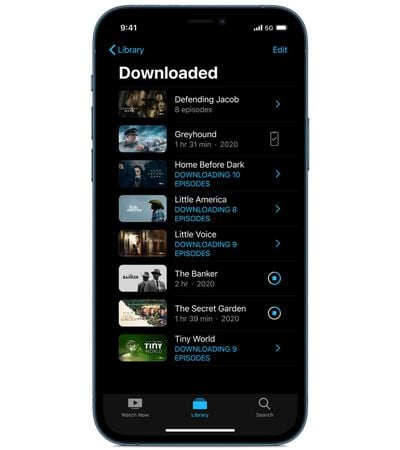
Sub-6GHz 5G is much more widespread and available in urban, suburban, and rural areas across the United States and other countries. For the most part, when you use a 5G network, you'll be using Sub-6GHz 5G. It's generally faster than LTE and speed is going to improve as the technology evolves, but it's not the super fast 5G you might be expecting.
The new iPhones support both mmWave and Sub-6GHz networks in the United States, but mmWave connectivity is not available in other countries. iPhones purchased outside of the United States do not have the mmWave antenna on the side and are not able to connect to mmWave networks. Apple made this decision because most countries do not have mmWave 5G networks available.
The iPhone 12 models use Qualcomm's X55 modem, but Apple created custom antennas and radio components to enhance connectivity, and through software optimization, Apple says apps can benefit from 5G without using additional power or impacting battery life.
5G Benefits
5G connectivity allows for faster download and upload speeds, which speeds up everything from loading websites to downloading TV shows and movies.
It also increases bandwidth for streaming services so you can watch in a higher resolution, and it brings improved FaceTime call quality. Over 5G or WiFi, FaceTime calls work in 1080p.
In areas where LTE speeds are slow because of the sheer number of people, 5G frees up bandwidth and reduces congestion for faster usage speeds.
5G Battery Drain
Battery tests suggest the iPhone 12 and 12 Pro see much faster battery drain when connected to 5G networks compared to when connected to LTE networks.
In a test using the same parameters, the iPhone 12 lasted for eight hours and 25 minutes, while the iPhone 12 Pro lasted for nine hours and six minutes when connected to 5G.
When connected to LTE, the iPhone 12 lasted for 1 hour and 23 minutes, while the iPhone 12 Pro lasted for 11 hours and 24 minutes.
5G Bands
iPhones in the United States support up to 20 5G bands.
Sub-6GHz: 5G NR (Bands n1, n2, n3, n5, n7, n8, n12, n20, n25, n28, n38, n40, n41, n66, n71, n77, n78, n79)
mmWave: 5G NR mmWave (Bands n260, n261)
LTE Bands
Along with 5G, the iPhone 12 models also support Gigabit LTE, so you can still connect to LTE networks when 5G networks aren't available. The following bands are supported:
FDD-LTE (Bands 1, 2, 3, 4, 5, 7, 8, 12, 13, 14, 17, 18, 19, 20, 25, 26, 28, 29, 30, 32, 66, 71)
TD-LTE (Bands 34, 38, 39, 40, 41, 42, 46, 48)
Data Saver Mode
Data Saver Mode is a feature that swaps the iPhone's connection over to LTE when 5G speeds aren't needed in order to preserve battery life.
As an example, when the iPhone is updating in the background, it uses LTE because super fast speeds aren't necessary, but in instances where speed does matter, such as downloading a show, the iPhone 12 models swap over to 5G. There is also a setting to use 5G whenever it's available rather than using the automatic Data Saver Mode.
Dual SIM Support
Dual SIM support allows two phone numbers to be used at one time, enabled through the inclusion of a physical nano-SIM slot and an eSIM. eSIM functionality is available in many countries around the world, and Apple has a list of carriers that support eSIM on its website.
Dual SIMs work with select carriers in Austria, Canada, Croatia, Czech Republic, Germany, Hungary, India, Spain, the UK, and the United States.
When using Dual SIM mode on the iPhone 12 models, 5G connectivity was not available at launch with speeds limited to LTE, but that changed with an iOS update. Apple enabled Dual SIM 5G support through the iOS 14.5 software update that was released in the spring.
5GHz Personal Hotspot
When using Personal Hotspot on the iPhone 12 models, devices are able to tether over faster 5GHz WiFi compared to the 2.4GHz limit on prior iPhones. The 5GHz option is enabled by default and has the potential to bring speed improvements to devices able to connect to 5GHz networks.
There is an option to disable the 5GHz connection to allow 2.4GHz devices to connect.
Bluetooth, WiFi, and U1 Chip
The iPhone 12 models include the same Apple-designed U1 chip that was first introduced in the iPhone 11 lineup. The U1 chip enables Ultra Wideband technology for improved spatial awareness, allowing the iPhone 12 models to precisely locate other U1-equipped Apple devices.
Apple has likened Ultra Wideband to "GPS at the scale of the living room," because the technology is designed for improved indoor positioning and location tracking.
The U1 chip allows the iPhone 12 Pro and iPhone 12 Pro Max to precisely track nearby AirTags. It's also used for directional AirDrop and interaction with the HomePod mini, which also has a U1 chip.
As for Bluetooth and WiFi, the iPhone 12 Pro models support Bluetooth 5.0 and WiFi 6, the newest and fastest WiFi protocol.
Other Features
Speaker
The iPhone 12 Pro models have a spatial audio feature that's designed to simulate surround sound for a more immersive audio experience. Dolby Atmos sound is also supported.
Sensors
The iPhone 12 Pro models are equipped with a barometer, three-axis gyroscope, accelerometer, proximity sensor, and an ambient light sensor.
GPS and NFC
Support for GPS, GLONASS, Galileo, QZSS, and BeiDou (new this year) location services is included in the iPhone 12 Pro and Pro Max.
NFC with reader mode is included, and there's a background tag feature that allows the iPhone models to scan NFC tags without the need to open an app first.
Storage Space
The iPhone 12 Pro and Pro Max start with 128GB of storage, with 256GB and 512GB available as upgrade options.
MagSafe
The iPhone 12 and 12 Pro models have a built-in magnetic ring that is designed to work with a MagSafe charger and other magnetic accessories.
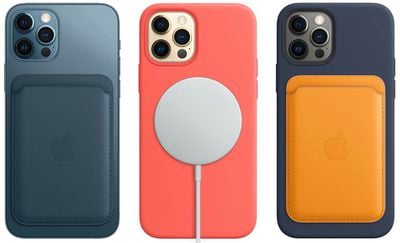
The MagSafe charger snaps right onto the back of the iPhone 12 and charges at 15W, up from the maximum 7.5W wireless charging available with Qi-based chargers. The charger is compatible with older iPhones, but is primarily designed to work with the new iPhone models.
Other magnetic accessories are compatible with the magnetic ring, including cases, sleeves, snap-on wallets, and more, with third-party companies also able to make accessories for the iPhone 12 lineup. For more on MagSafe, make sure to check out our MagSafe guide.
MagSafe Charging
Testing suggests the MagSafe charger charges more than two times slower than a wired 20W USB-C charger. With the 20W charger, a dead iPhone was able to charge to 50 percent in 28 minutes, and the same 50 percent charge took an hour over MagSafe.
Battery testing comparing the iPhone 12 and 12 Pro models with the iPhone 12 Pro, Pro Max, and iPhone 11, saw the Pro Max and Pro outperform this years iPhones. Rankings were as follows:
- iPhone 11 Pro Max: 8 hours and 29 minutes
- iPhone 11 Pro: 7 hours and 36 minutes
- iPhone 12: 6 hours and 41 minutes
- iPhone 12 Pro: 6 hours and 35 minutes
- iPhone 11: 5 hours and 8 minutes
- iPhone XR: 4 hours and 31 minutes
- iPhone SE (2020): 3 hours and 59 minutes
Apple warns that MagSafe Chargers can leave a circular imprint on its leather cases, and a similar effect has been seen on silicone cases. Apple also says that credit cards, security badges, passports, and keyfobs should not be placed between the iPhone and MagSafe charger.
Like all iPhones, the iPhone 12 models with their MagSafe technology can cause interference with medical devices like pacemakers and defibrillators. Apple recommends keeping iPhone 12 models and all MagSafe accessories a safe distance away from implanted medical devices.
A safe distance is considered more than 6 inches / 15 cm apart or more than 12 inches / 30 cm apart if wirelessly charging. Though there are more magnets in the iPhone 12 models, Apple says that they are "not expected to pose a greater risk of magnetic interference to medical devices than prior iPhone models," and the U.S. FDA has said that the risk of MagSafe interference with pacemakers is low.
MagSafe Battery Pack
In July of 2021, Apple launched the MagSafe Battery Pack for $99, designed to work with the iPhone 12 mini, iPhone 12, iPhone 12 Pro, and iPhone 12 Pro Max. The MagSafe Battery Pack is available in white only and attaches magnetically to the back of one of the iPhone models, with the magnets keeping it aligned to your iPhone.
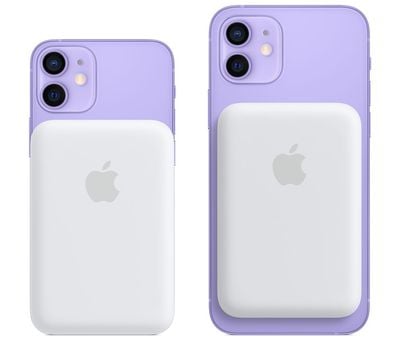
The accessory has an 11.13Wh battery, which offers a partial charge for the iPhone. For comparison, the iPhone has a 10.78Wh battery, but Qi charging is inefficient, resulting in power loss. While on the go, the MagSafe Battery Pack can charge an iPhone at 5W, but plugged in, it can be charged at up to 15W.
The MagSafe Battery Pack and the iPhone can be charged at the same time. Apple says that a Lightning cable can be plugged into the MagSafe Battery Pack for up to 15W of wireless charging, and with a 20W charger, the MagSafe Battery Pack and the iPhone will charge even faster. Apple recommends a 20W or higher USB-C Power Adapter and USB-C to Lightning Cable for charging the MagSafe Battery Pack.
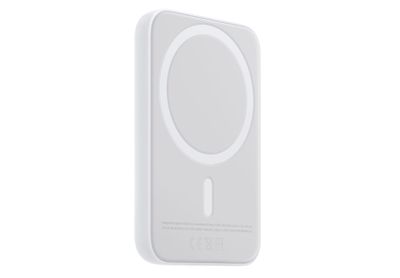
The MagSafe Battery Pack can also be charged through the iPhone if the iPhone is plugged into a power source. Apple suggests users might want to charge this way if the iPhone needs to connect to another device while charging, such as wired CarPlay or transferring photos to a Mac.
For more about Apple's MagSafe Battery Pack, see our dedicated guide.
No Power Adapter
The iPhone 12 Pro and Pro Max do not come with a power adapter or EarPods in the box, as Apple eliminated them to lower its environmental impact. The new iPhones ship in a smaller, slimmer box and come with just a standard USB-C to Lightning cable.
iPhone 12
The iPhone 12 Pro and Pro Max are being sold alongside the iPhone 12 and 12 mini, two more affordable iPhone options. The iPhone 12 models have many of the same features as the iPhone 12 Pro models, such as 5G connectivity, edge-to-edge OLED displays, and the A14 chip, but have less expensive build materials (an aluminum frame instead of a stainless steel frame), dual-lens camera setups with fewer bells and whistles, and a wide range of colors to choose from.
For details on the iPhone 12 and 12 mini, make sure to check out our iPhone 12 roundup, and if you're trying to choose between the iPhone 12 and 12 Pro, check out our Buyer's Guide.

